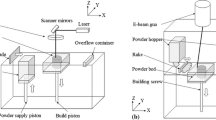Processes are considered from the position of synergetics occurring during cutting brittle inorganic non-metallic materials with a diamond tool, particularly in the working region between a cutting tool and material being machined, cut material structure and diamond cutting tool evolution, and question of implementing a cutting tool self-sharpening regime.














Similar content being viewed by others
References
GOST 16115–88 (ISO 6105–88), Diamond cutting wheels of segmented shape 1A1RSS/C1 and 1A1RSS/C2. Technical conditions. IPK Izd. Standartov, Moscow (1998).
J. Konstanty, Cobalt as a Matrix in Diamond Impregnating Tools for Stone Sawing Applications, Wydawnictwa AGH, Krakow (2002).
J. Konstanty, “Diamond bonding and matrix wear mechanisms involved in circular sawing of stone,” Industrial Diamond Review, No. 1, 55 – 65 (2000).
Yu. L. Klimotovich, “Introduction to open system physics. In two parts,” in: Synergetics. Work of Seminar. Vol. 3: Round table proc. “Self-organization and synergetics: Ideas, approaches, prospects,” Izd. MGU, Moscow (2000).
A. V. Belyakov, “Principal bifurcations in firing of compact oxide ceramics,” Glass and Ceramics, 57(10), 345 – 349 (2000).
A. V. Belyakov, “Synergistic and quasichemical approaches in ceramic technology (a review),” Glass and Ceramics, 60(9/10), 274 – 278 (2003).
A. V. Belyakov, A. I. Zakharov, and T. V. Tselykovskaya, “ Frill-like defect in glazes in the context of synergism,” Glass and Ceramics, 55(11/12), 353 – 356 (1998).
A. Yu. Loskutov Loskutov, “Reproducibility of the structure and properties of parts and their description within the framework of nonlinear dynamics,” Glass and Ceramics, 57(7 / 8), 243 – 246 (2000).
V. S. Bakunov and A. V. Belyakov, “Prospects of improving the reproducibility of the structure and properties of ceramics,” Refr. Industr. Ceram., 39(1/2), 51 – 55 (1998).
V. S. Bakunov and A. V. Belyakov, “Analyzing the structure of ceramics,” Inorgan. Mater., 32(2), 220 – 222 (1996).
Zh. A. Kazaryan. Natural Stone: Recovery, Treatment, Use: Handbook [in Russian], Petrokomplekt, Moscow (2002).
P. R. Davis, M. L. Fish, S. Peacock, and D. N.Wright, “An indicator system for saw grit,” Industrial Diamond Review, No. 3, 78 – 87 (1996).
S. P. Pyun, H. W. Lee, and J. H. Park, “Study for cutting performance in arrayed diamond saw blade,” 1st International Industrial Diamond Conference, 20 – 21 October 2005, Barcelona.
A. Engels, “The role of particles per carat in diamond tools behavior,” Industrial Diamond Review, No. 2, 39 – 45 (2003).
G. D. Pershin and A. M. Akhmetshin, “Effect of force regime and depth of scoring on machinability of natural stone by a diamond-disk tool,” in: Recovery, Treatment, and Use of Natural Stone [in Russian], Izd. MGTU, Magnitogorsk (2006).
E. A. Varentsov and Yu. A. Khrustalev, “Mechanoemission and mechanochemistry of molecular organic crystals,” Russian Chem. Rev., 64(8), 793 – 798 (1995).
G. I. Disiler, V. P. Vlasov, Yu. M. Gerasimov, et al., Decorative Surface of Solids [in Russian], Nauka, Moscow (1976).
ZENESIS. World’s most advanced patterned technology. Product catalog EHWA Diamond Industrial Co., Ltd (http://www.zenesistechnology.com).
Product catalog Jack Midhage Diamond Production AB. Diamond Tools and Machines for the Construction Industry. Oct. 2011. 63 p. (http://www.midhage.se/eng/midhage_productcatalogue_2011.pdf).
V. I. Lavrinenko, O. A. Pasichnyi, G. B. Sytnik, and A. A. Levitskii, “Study of features of sintered composite with an ordered structure,” Protsesi. Mekhan. Obrob. Mashin., No. 7, 105 – 112 (2009).
A. V. Belyakov and S. I. Tserman, “Cutting of Bakor by a segmented tool with clustered diamonds,” Refr. Industr. Ceram., 52(3), 195 – 198 (2011).
Author information
Authors and Affiliations
Corresponding author
Additional information
Translated from Novye Ogneupory, No. 3, pp. 105 – 118, March, 2014.
Rights and permissions
About this article
Cite this article
Belyakov, A.V., Tserman, S.I. Cutting Brittle Inorganic Nonmetallic Materials With a Diamond Tool from the Position of Synergetics. Refract Ind Ceram 55, 97–107 (2014). https://doi.org/10.1007/s11148-014-9668-1
Received:
Published:
Issue Date:
DOI: https://doi.org/10.1007/s11148-014-9668-1




